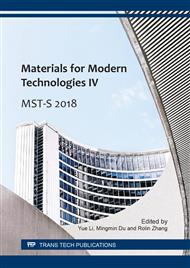p.119
p.128
p.134
p.141
p.149
p.157
p.168
p.177
p.184
Effect of Reheating and Deformation Processes on DWTT Performance for Heavy Gauge Pipeline Steel
Abstract:
DWTT (Drop weigh tear test) is an effective way to evaluate the fracture propagation for pipeline steel. The effects of slab reheating temperature, soaking time, single pass reduction ratio during recrystallization zone rolling and transfer bar ratio during non-recrystallization zone rolling on DWTT performance were studied for heavy gauge pipeline steel. And the grain refinement and toughening mechanism were discussed. It was found that the grain in the core of the plate can be refined by reducing the reheating temperature, increasing the single pass reduction ratio during recrystallization zone rolling and setting suitable transfer bar ratio during non-recrystallization zone rolling, which promote the DWTT property improvement for heavy gauge pipeline steel. The 30.9mm heavy gauge pipeline steel plate was industrial produced and the X70 UOE welded pipe with dimension in Φ1219×30.9mm was manufactured. The DWTT 85%FATT (fracture appearance transition temperature) of pipe body is as low as -20°C.
Info:
Periodical:
Pages:
149-156
Citation:
Online since:
May 2018
Authors:
Keywords:
Price:
Сopyright:
© 2018 Trans Tech Publications Ltd. All Rights Reserved
Share:
Citation:


